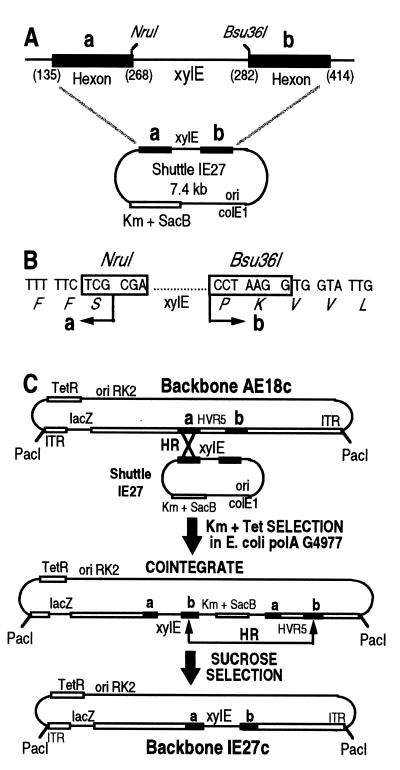FIG. 1.
Modification of the Ad5 hexon monomer by recombinational cloning in E. coli. (A) Shuttle plasmid IE27 (the detailed construction strategy is available upon request) is a kanamycin (Km)-selectable plasmid in which the xylE phenotypic marker has been inserted in place of HVR5 of Ad5 (residues 268 to 282). Its replication requires the polA gene product of E. coli. SacB is a suicide gene for E. coli in the presence of sucrose as the carbon source. a and b refer to HVR5-flanking sequences from Ad5 (numbers in parentheses refer to hexon amino acid numbering). (B) The xylE phenotypic marker of shuttle plasmid IE27 is bordered by unique NruI and Bsu36I sites to facilitate subsequent HVR5 modifications. (C) Principle of HVR5 modification by homologous recombination in E. coli (adapted from reference 5). Homologous recombination (HR) between identical sequences (black bars a and b) from a suicide ColE1 shuttle plasmid (e.g., IE27) and an RK2-derived (replication is polA independent) plasmid (e.g., AE18c) in a polA mutant of E. coli generates a kanamycin (Km)- and tetracycline (Tet)-selectable cointegrate. Resolution of the cointegrate by HR leads to the loss of the sacB suicide gene, which is selected by using sucrose as a carbon source. Depending on the recombination pathway, resolution of the cointegrate generates either the starting backbone AE18c or the xylE-containing IE27c backbone, which can be differentiated upon catechol addition (26). IE27c has been used as a recipient backbone to generate all HVR5-modified backbones and viruses used in this study (see the text).

